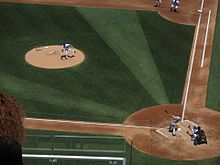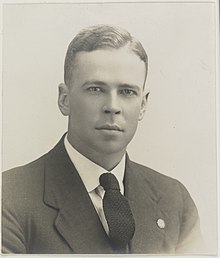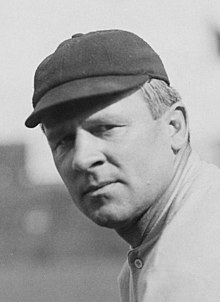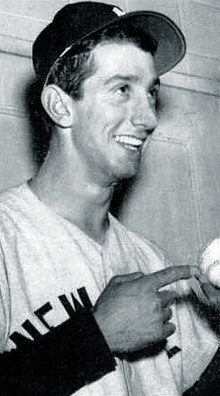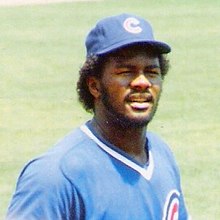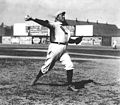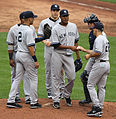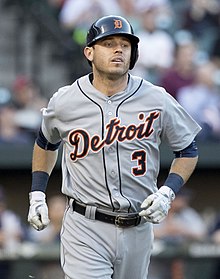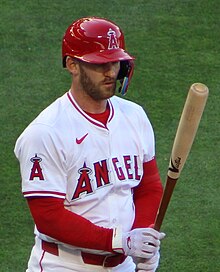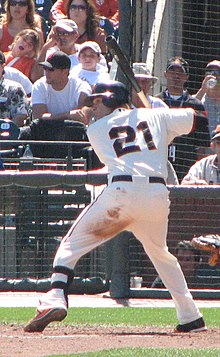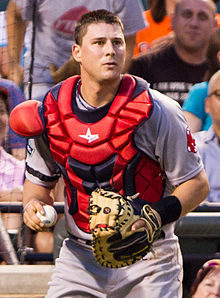Portal:Baseball
Portal maintenance status: (June 2018)
|
| Main page | Content, Categories & Topics | WikiProjects & Things you can do |
The Baseball Portal
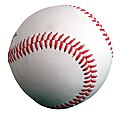
Baseball is a bat-and-ball sport played between two teams of nine players each, taking turns batting and fielding. The game occurs over the course of several plays, with each play generally beginning when a player on the fielding team, called the pitcher, throws a ball that a player on the batting team, called the batter, tries to hit with a bat. The objective of the offensive team (batting team) is to hit the ball into the field of play, away from the other team's players, allowing its players to run the bases, having them advance counter-clockwise around four bases to score what are called "runs". The objective of the defensive team (referred to as the fielding team) is to prevent batters from becoming runners, and to prevent runners advancing around the bases. A run is scored when a runner legally advances around the bases in order and touches home plate (the place where the player started as a batter).
The opposing teams switch back and forth between batting and fielding; the batting team's turn to bat is over once the fielding team records three outs. One turn batting for each team constitutes an inning. A game is usually composed of nine innings, and the team with the greater number of runs at the end of the game wins. Most games end after the ninth inning, but if scores are tied at that point, extra innings are usually played. Baseball has no game clock, though some competitions feature pace-of-play regulations such as the pitch clock to shorten game time.
Baseball evolved from older bat-and-ball games already being played in England by the mid-18th century. This game was brought by immigrants to North America, where the modern version developed. Baseball's American origins, as well as its reputation as a source of escapism during troubled points in American history such as the American Civil War and the Great Depression, have led the sport to receive the moniker of "America's Pastime"; since the late 19th century, it has been unofficially recognized as the national sport of the United States, though in modern times is considered less popular than other sports, such as American football. In addition to North America, baseball spread throughout the rest of the Americas and the Asia–Pacific in the 19th and 20th centuries, and is now considered the most popular sport in parts of Central and South America, the Caribbean, and East Asia, particularly in Japan, South Korea, and Taiwan. (Full article...)
 Featured articles - load new batch
Featured articles - load new batch
-
Image 1
Marcus Elmore Baldwin (October 29, 1863 – November 10, 1929), nicknamed "Fido" and "Baldy", was an American professional baseball pitcher who played seven seasons in Major League Baseball (MLB). In 346 career games, he pitched to a 154–165 win–loss record with 295 complete games. Baldwin set the single-season MLB wild pitches record with 83 that still stands today.
Born in Pittsburgh, Pennsylvania, Baldwin made his professional debut for a Cumberland, Maryland, team in 1883. Though signed by Chicago White Stockings president Albert Spalding to pitch against the St. Louis Browns in the 1886 World Series, Baldwin did not play after the Browns objected. He made his MLB debut for the White Stockings in 1887, when a writer for the Oshkosh Daily Northwestern called him the "swiftest pitcher in the National League" (NL). Released by Chicago player–manager Cap Anson, he signed with the Columbus Solons of the American Association (AA) in 1889, where he led the league in innings pitched (513+2⁄3), losses (34), strikeouts (368), and walks (274). (Full article...) -
Image 2
A picture of a Wii Sports disc
Wii Sports is a 2006 sports simulation video game developed and published by Nintendo for the Wii video game console. The game was released in North America along with the Wii on November 19, 2006, and in Japan, Australia, and Europe the following month. It was included as a pack-in game with the console in all territories except Japan, making it the first sports game included with the launch of a Nintendo system since Mario's Tennis for the Virtual Boy in 1995. The game was later released on its own as part of the Nintendo Selects collection of games.
Wii Sports is a collection of five sports simulations designed to demonstrate the motion-sensing capabilities of the Wii Remote. The five sports included are tennis, baseball, bowling, golf, and boxing. Players use the Wii Remote to mimic actions performed in real-life sports, such as swinging a tennis racket or rolling a bowling ball. The rules for each game are simplified to make them more accessible to new players. The game also features training and fitness modes that monitor players' progress in the sports. (Full article...) -
Image 3
Michael Jeffrey Jordan (born February 17, 1963), also known by his initials MJ, is an American businessman and former professional basketball player. He played 15 seasons in the National Basketball Association (NBA) between 1984 and 2003, winning six NBA championships with the Chicago Bulls. He was integral in popularizing basketball and the NBA around the world in the 1980s and 1990s, becoming a global cultural icon. His profile on the NBA website states, "By acclamation, Michael Jordan is the greatest basketball player of all time."
Jordan played college basketball with the North Carolina Tar Heels. As a freshman, he was a member of the Tar Heels' national championship team in 1982. Jordan joined the Bulls in 1984 as the third overall draft pick and quickly emerged as a league star, entertaining crowds with his prolific scoring while gaining a reputation as one of the best defensive players. His leaping ability, demonstrated by performing slam dunks from the free-throw line in Slam Dunk Contests, earned him the nicknames "Air Jordan" and "His Airness". Jordan won his first NBA title with the Bulls in 1991 and followed that achievement with titles in 1992 and 1993, securing a three-peat. Citing physical and mental exhaustion from basketball and superstardom, Jordan abruptly retired from basketball before the 1993–94 NBA season to play Minor League Baseball in the Chicago White Sox organization. He returned to the Bulls in March 1995 and led them to three more championships in 1996, 1997, and 1998, as well as a then-record 72 regular season wins in the 1995–96 NBA season. Jordan retired for the second time in January 1999, returning for two more NBA seasons from 2001 to 2003 as a member of the Washington Wizards. He was selected to play for the United States national team during his college and NBA careers, winning four gold medals—at the 1983 Pan American Games, 1984 Summer Olympics, 1992 Tournament of the Americas and 1992 Summer Olympics—while also being undefeated. (Full article...) -
Image 4
Osborne Earl Smith (born December 26, 1954) is an American former professional baseball player. Nicknamed "The Wizard of Oz", Smith played shortstop for the San Diego Padres and St. Louis Cardinals in Major League Baseball, winning the National League Gold Glove Award for defensive play at shortstop for 13 consecutive seasons. A 15-time All-Star, Smith accumulated 2,460 hits and 580 stolen bases during his career, and won the National League Silver Slugger Award as the best hitter at shortstop in 1987. He was elected to the Baseball Hall of Fame in his first year of eligibility in 2002. He was also elected to the St. Louis Cardinals Hall of Fame in the inaugural class of 2014.
Smith was born in Mobile, Alabama; his family moved to Watts, Los Angeles, when he was six years old. While participating in childhood athletic activities, Smith possessed quick reflexes; he went on to play baseball at Locke High School in Los Angeles, then at California Polytechnic State University, San Luis Obispo. Drafted as an amateur player by the Padres, Smith made his major league debut in 1978. He quickly established himself as an outstanding fielder, and later became known for performing backflips on special occasions while taking his position at the beginning of a game. Smith won his first Gold Glove Award in 1980 and made his first All-Star Game appearance in 1981. (Full article...) -
Image 5
Herschel Greer Stadium was a Minor League Baseball park in Nashville, Tennessee, on the grounds of Fort Negley, an American Civil War fortification, approximately two mi (3.2 km) south of the city's downtown district. The facility closed at the end of the 2014 baseball season and remained deserted for over four years until its demolition in 2019. Following an archaeological survey, the land is expected to be reincorporated into Fort Negley Park.
Greer was opened in 1978 for the Nashville Sounds, an expansion franchise of the Double-A Southern League who moved to the Triple-A American Association in 1985 and to the Triple-A Pacific Coast League in 1998. The stadium played host to the team until 2014. The subject of numerous upgrades and repairs to maintain its functionality, Greer became one of the oldest stadiums used by a Triple-A team and had fallen well below professional baseball's standards for a stadium at that class level by the end of its use. For over a decade, the Sounds attempted to secure agreements with the Metropolitan Government of Nashville and Davidson County for a new ballpark to replace Greer, eventually resulting in the construction of First Tennessee Park, which became the Sounds' new home in 2015. (Full article...) -
Image 6
Daniel Lucius "Doc" Adams (November 1, 1814 – January 3, 1899) was an American baseball player and executive who is regarded by historians as an important figure in the sport's early years. For most of his career he was a member of the New York Knickerbockers. He first played for the New York Base Ball Club in 1840 and started his Knickerbockers career five years later, continuing to play for the club into his forties and to take part in inter-squad practice games and matches against opposing teams. Researchers have called Adams the creator of the shortstop position, which he used to field short throws from outfielders. In addition to his playing career, Adams manufactured baseballs and oversaw bat production; he also occasionally acted as an umpire.
From 1847 to 1861, the Knickerbockers selected Adams as their president six times, and as a vice president, treasurer, or director in six other years. As president of the club, Adams was an advocate of rule changes in baseball that resulted in nine-man teams and nine-inning games. When the National Association of Base Ball Players (NABBP) was formed in 1858, he led the rules and regulations committee of the new organization. In his role, Adams ruled that the fields' bases should be 90 feet (27 m) apart, the modern distance, and supported the elimination of the "bound rule", which allowed for balls caught after one bounce to be recorded as outs. He resigned from his positions with the Knickerbockers and NABBP in 1862. Adams' contributions in creating baseball's rules went largely unrecognized for decades after his 1899 death, but in 1980 a letter about him appeared in The New York Times; by 1993, researcher John Thorn had written about Adams' role. Other historians have given him credit for helping to develop the sport, and Thorn has called Adams "first among the Fathers of Baseball". (Full article...) -
Image 7
Riders Field, formerly known as Dr Pepper/Seven Up Ballpark and Dr Pepper Ballpark, is a baseball park in Frisco, Texas, United States. The home of the Double-A Frisco RoughRiders of the Texas League, it opened on April 3, 2003, and can seat up to 10,216 people. Though primarily a venue for Minor League Baseball games, the facility also hosts high school and college baseball tournaments, and other public and private events throughout the year. It has been the site of three Texas League All-Star Games.
Since its opening, Riders Field has won awards and garnered praise for its unique design, feel, and numerous amenities. In his design, park architect David M. Schwarz desired the creation of a village-like "park within a (ball)park". The stadium received the 2003 Texas Construction Award for Best Architectural Design. (Full article...) -
Image 8
William Harold Ponsford MBE (19 October 1900 – 6 April 1991) was an Australian cricketer. Usually playing as an opening batsman, he formed a successful and long-lived partnership opening the batting for Victoria and Australia with Bill Woodfull, his friend and state and national captain. Ponsford is the only player to twice break the world record for the highest individual score in first-class cricket; Ponsford and Brian Lara are the only cricketers to twice score 400 runs in an innings. Ponsford holds the Australian record for a partnership in Test cricket, set in 1934 in combination with Don Bradman (451 for 2nd wicket)—the man who broke many of Ponsford's other individual records. In fact, he along with Bradman set the record for the highest partnership ever for any wicket in Test cricket history when playing on away soil (451 runs for the second wicket)
Despite being heavily built, Ponsford was quick on his feet and renowned as one of the finest ever players of spin bowling. His bat, much heavier than the norm and nicknamed "Big Bertha", allowed him to drive powerfully and he possessed a strong cut shot. However, critics questioned his ability against fast bowling, and the hostile short-pitched English bowling in the Bodyline series of 1932–33 was a contributing factor in his early retirement from cricket a year and a half later. Ponsford also represented his state and country in baseball, and credited the sport with improving his cricketing skills. (Full article...) -
Image 9William Derrick Bates (born December 7, 1963) is an American former professional baseball second baseman and pinch runner who played in Major League Baseball (MLB) for the Milwaukee Brewers and the Cincinnati Reds. In 29 career games, Bates had a batting average of .125 with six hits, two runs batted in (RBI), 11 runs, and eight stolen bases. Though his defensive position was at second base, the Reds primarily used Bates as a pinch runner. After he scored the winning run in Game 2 of the 1990 World Series, Bates never played in MLB again.
Born in Houston, Bates attended the University of Texas and, in his freshman season, won the 1983 College World Series as a part of the Texas Longhorns baseball team. For the next two seasons, Bates was named to the College Baseball All-America Team, a team composed of the best collegiate baseball athletes in America. Drafted by Milwaukee in the fourth round of the 1985 MLB draft, he rose through the Brewers' farm system helping several of his minor league teams win their respective league titles. He made his MLB debut in 1989, after Milwaukee's starting second baseman Jim Gantner was injured. A trade in 1990 sent Bates to Cincinnati, where the Reds used him primarily as a pinch runner at the end of the regular season and into the postseason. Facing the Oakland Athletics in the World Series, Bates reached base on a pinch hit single against Dennis Eckersley and later scored the winning run in Game 2 as the Reds swept the Athletics four games to none. Following the World Series championship, the Reds re-signed Bates on a one-year contract, and he played for their Triple-A team. He spent the next year with the Chicago Cubs Triple-A affiliate, and last played exhibition baseball in 1995. After retiring, he worked as an equipment supplier in the oil and gas industry in Houston. (Full article...) -
Image 10
John Joseph McGraw (April 7, 1873 – February 25, 1934) was an American Major League Baseball (MLB) player and manager who was for almost thirty years manager of the New York Giants. He was also the third baseman of the pennant-winning 1890s Baltimore Orioles teams, noted for their innovative, aggressive play.
McGraw was born into poverty in Truxton, New York. He found an escape from his hometown and a bad family situation through baseball, beginning a quick rise through the minor leagues that led him to the Orioles at the age of 18. Under the tutelage of manager Ned Hanlon, the Orioles of the 1890s won three National League (NL) pennants; McGraw was one of the stalwarts of the team alongside Wee Willie Keeler, Hughie Jennings, and Wilbert Robinson. The Orioles perfected the hit and run play and popularized the Baltimore chop; they also sought to win by intimidating the opposing team and the umpire. (Full article...) -
Image 11
Alfred Manuel "Billy" Martin Jr. (May 16, 1928 – December 25, 1989) was an American Major League Baseball second baseman and manager who, in addition to leading other teams, was five times the manager of the New York Yankees. First known as a scrappy infielder who made considerable contributions to the championship Yankee teams of the 1950s, he then built a reputation as a manager who would initially make bad teams good, before ultimately being fired amid dysfunction. In each of his stints with the Yankees he managed them to winning records before being fired by team owner George Steinbrenner or resigning under fire, usually amid a well-publicized scandal such as Martin's involvement in an alcohol-fueled fight.
Martin was born in a working-class section of Berkeley, California. His skill as a baseball player gave him a route out of his home town. Signed by the Pacific Coast League Oakland Oaks, Martin learned much from Casey Stengel, the man who would manage him both in Oakland and in New York, and enjoyed a close relationship with Stengel. Martin's spectacular catch of a wind-blown Jackie Robinson popup late in Game Seven of the 1952 World Series saved that series for the Yankees, and he was the hitting star of the 1953 World Series, earning the Most Valuable Player award in the Yankee victory. He missed most of two seasons, 1954 and 1955, after being drafted into the Army, and his abilities never fully returned; the Yankees traded him after a brawl at the Copacabana club in New York during the 1957 season. Martin bitterly resented being traded, and did not speak to Stengel for years, a time during which Martin completed his playing career with various teams. (Full article...) -
Image 12
Lee Arthur Smith (born December 4, 1957) is an American former professional baseball pitcher who played 18 years in Major League Baseball (MLB) for eight teams. Serving mostly as a relief pitcher during his career, he was a dominant closer, was the first pitcher to reach 400 saves, and held the major league record for career saves from 1993 until 2006, when Trevor Hoffman passed his total of 478. He was elected to the National Baseball Hall of Fame as part of the class of 2019 by the Today's Game Era Committee.
A native of Jamestown in Bienville Parish in north Louisiana, Smith was scouted by Buck O'Neil and was selected by the Chicago Cubs in the 1975 MLB draft. Smith was an intimidating figure on the pitcher's mound at 6 feet 6 inches (1.98 m) and 265 pounds (120 kg) with a 95-mile-per-hour (150 km/h) fastball. In 1991, he set a National League (NL) record with 47 saves for the St. Louis Cardinals, and was runner-up for the league's Cy Young Award; it was the second of three times Smith led the NL in saves, and he later led the American League (AL) in saves once. When he retired, he held the major league record for career games finished (802) and was third in games pitched (1,022). He holds the Cubs' team record for career saves (180), and held the same record for the Cardinals (160) until 2006. (Full article...) -
Image 13

On July 10, 1932, the Philadelphia Athletics beat the Cleveland Indians 18–17 in 18 innings in a Major League Baseball game played at League Park in Cleveland. Several major-league records were set during the game; for example, Johnny Burnett of the Indians became the only player to hit safely nine (or even eight) times in a game, while Cleveland's 33 hits and the teams' combined 58 hits are also single-game records. Pitcher Eddie Rommel secured the win for the Athletics, pitching an American League-record 17 innings in relief after Philadelphia's Lew Krausse gave up three runs in the first inning. The 29 hits Rommel allowed are a major-league record; the 14 runs against him are the most given up by a winning pitcher.
Coming into the game, the Athletics, who were the three-time defending American League champions, trailed the New York Yankees in the standings by 71⁄2 games. Sunday baseball was still illegal in Philadelphia, forcing the Athletics to make one-game road trips on some Sundays, including July 10. With his pitching staff exhausted by six games in the previous three days, the owner and manager of the Athletics, Connie Mack, took only two pitchers on the train trip to Cleveland, giving the rest of the staff the day off. With no chance of being relieved except by a position player, Rommel pitched with mixed effectiveness, giving up six runs in the seventh inning but only two runs in the final nine innings of the game. He aided his own cause by getting three hits in seven at bats. Cleveland's Wes Ferrell took the loss after Jimmie Foxx got his sixth hit of the game and then scored. Foxx had already batted in eight runs, having hit three home runs and accumulated sixteen total bases, tying a record that has since been broken. (Full article...) -
Image 14
Earvin "Magic" Johnson Jr. (born August 14, 1959) is an American businessman and former professional basketball player. Often regarded as the greatest point guard of all time, Johnson spent his entire career with the Los Angeles Lakers in the National Basketball Association (NBA). After winning a national championship with the Michigan State Spartans in 1979, Johnson was selected first overall in the 1979 NBA draft by the Lakers, leading the team to five NBA championships during their "Showtime" era. Johnson retired abruptly in 1991 after announcing that he had contracted HIV, but returned to play in the 1992 All-Star Game, winning the All-Star MVP Award. After protests against his return from his fellow players, he retired again for four years, but returned in 1996, at age 36, to play 32 games for the Lakers before retiring for the third and final time.
Known for his extraordinary court vision, passing abilities, and leadership, Johnson was one of the most dominant players of his era. His career achievements include three NBA Most Valuable Player Awards, three NBA Finals MVPs, nine All-NBA First Team designations, and twelve All-Star games selections. He led the league in regular season assists four times, and is the NBA's all-time leader in average assists per game in both the regular season (11.19 assists per game) and the playoffs (12.35 assists per game). He also holds the records for most career playoff assists and most career playoff triple-doubles. Johnson was the co-captain of the 1992 United States men's Olympic basketball team ("The Dream Team"), which won the Olympic gold medal in Barcelona; Johnson hence became one of eight players to achieve the basketball Triple Crown. After leaving the NBA in 1991, he formed the Magic Johnson All-Stars, a barnstorming team that traveled around the world playing exhibition games. (Full article...) -
Image 15

Depiction of the game from The Boston Globe
On Saturday, May 1, 1920, the Brooklyn Dodgers and the Boston Braves played to a 1–1 tie in 26 innings, the most innings ever played in a single game in the history of Major League Baseball (MLB). The game was played at Braves Field in Boston before a crowd estimated at 4,000. Both Leon Cadore of Brooklyn and Joe Oeschger of Boston pitched complete games, and with 26 innings pitched, jointly hold the record for the longest pitching appearance in MLB history. Their record is considered unbreakable, as modern pitchers rarely pitch even nine innings, and newer baseball rules have made long extra-innings games a rarity.
The day of the game saw rainy weather, and it was uncertain if the game would be played, but the skies cleared enough to allow it to proceed. Brooklyn scored a run in the fifth inning, and Boston in the sixth; thereafter, the pitchers became increasingly dominant. As the game exceeded eighteen innings, the small crowd at Braves Field cheered both pitchers. The last twenty innings were scoreless, and when darkness started to fall, the umpires called a halt after the twenty-sixth inning, as baseball fields did not yet have artificial lighting. (Full article...)
General images - load new batch
-
Image 21906 World Series, infielders playing "in" for the expected bunt and the possible play at the plate with the bases loaded (from Baseball rules)
-
Image 3Cover of Official Base Ball Rules, 1921 edition, used by the American League and National League (from Baseball rules)
-
Image 5A batter follows through after swinging at a pitched ball. (from Baseball rules)
-
Image 6The strike zone determines the result of most pitches, and varies in vertical length for each batter. (from Baseball)
-
Image 8Sadaharu Oh managing the Japan national team in the 2006 World Baseball Classic. Playing for the Central League's Yomiuri Giants (1959–80), Oh set the professional world record for home runs with 868. (from History of baseball)
-
Image 112013 World Baseball Classic championship match between the Dominican Republic and Puerto Rico, March 20, 2013 (from Baseball)
-
Image 12Alexander Cartwright, father of modern baseball (from History of baseball)
-
Image 14A pitcher handing off the ball after being taken out of the game during a mound meeting. (from Baseball)
-
Image 15A game from the Cantigas de Santa Maria, c. 1280, involving tossing a ball, hitting it with a stick and competing with others to catch it (from History of baseball)
-
Image 16In May 2010, the Philadelphia Phillies' Roy Halladay pitched the 20th major league perfect game. That October, he pitched only the second no-hitter in MLB postseason history. (from History of baseball)
-
Image 19The NL champion New York Giants baseball team, 1913. Fred Merkle, sixth in line, had committed a baserunning gaffe in a crucial 1908 game that became famous as Merkle's Boner. (from History of baseball)
-
Image 20Fenway Park, home of the Boston Red Sox. The Green Monster is visible beyond the playing field on the left. (from Baseball)
-
Image 21The American Tobacco Company's line of baseball cards featured shortstop Honus Wagner of the Pittsburgh Pirates from 1909 to 1911. In 2007, the card shown here sold for $2.8 million. (from Baseball)
-
Image 22A well-worn baseball (from Baseball)
-
Image 23Baserunners generally stand a short distance away from their base between pitches, preparing themselves to either go back or steal the next base. (from Baseball rules)
-
Image 24A first baseman receives a pickoff throw, as the runner dives back to first base. (from Baseball)
-
Image 25Cy Young—the holder of many major league career marks, including wins and innings pitched, as well as losses—in 1908. MLB's annual awards for the best pitcher in each league are named for Young. (from Baseball)
-
Image 26The typical motion of a right-handed pitcher (from Baseball rules)
-
Image 27An Afghan girl playing baseball in August 2002 (from Baseball)
-
Image 28Pitchers are generally substituted during mound visits (team gatherings at the pitcher's mound). (from Baseball rules)
-
Image 29Sadaharu Oh managing the Japan national team in the 2006 World Baseball Classic. Playing for the Central League's Yomiuri Giants (1959–80), Oh set the professional world record for home runs. (from Baseball)
-
Image 30Baseball games sometimes end in a walk-off home run, with the batting team usually gathering at home plate to celebrate the scoring of the winning run(s). (from Baseball rules)
-
Image 31Japanese-Americans spectating a World War II-era game while in an internment camp. America's ties to immigrants and to Japan have been deeply shaped by a shared baseball heritage. (from History of baseball)
-
Image 32Jackie Robinson in 1945, with the era's Kansas City Royals, a barnstorming squad associated with the Negro American League's Kansas City Monarchs (from History of baseball)
-
Image 34Rickey Henderson—the major leagues' all-time leader in runs and stolen bases—stealing third base in a 1988 game (from Baseball)
-
Image 35A New York Yankees batter (Andruw Jones) and a Boston Red Sox catcher at Fenway Park (from Baseball)
-
Image 37Pick-off attempt on runner (in red) at first base (from Baseball rules)
-
Image 38The standard fielding positions (from Baseball rules)
-
Image 39Diagram of a baseball field Diamond may refer to the square area defined by the four bases or to the entire playing field. The dimensions given are for professional and professional-style games. Children often play on smaller fields. (from Baseball)
-
Image 40By the 1860s Civil War, baseball (bottom) had overtaken its fellow bat-and-ball sport cricket (top) in popularity within the United States. (from History of baseball)
-
Image 41A runner sliding into home plate and scoring. (from Baseball)
-
Image 42Jackie Robinson in 1945, with the era's Kansas City Royals, a barnstorming squad associated with the Negro American League's Kansas City Monarchs (from Baseball)
-
Image 43The strike zone, which determines the outcome of most pitches, varies in vertical length depending on the batter's typical height while swinging. (from Baseball rules)
-
Image 44Pesäpallo, a Finnish variation of baseball, was invented by Lauri "Tahko" Pihkala in the 1920s, and after that, it has changed with the times and grown in popularity. Picture of Pesäpallo match in 1958 in Jyväskylä, Finland. (from Baseball)
-
Image 45Diagram indicating the standard layot of positions (from Baseball)
 Good articles - load new batch
Good articles - load new batch
-
Image 1
Scott Wynne Feldman (born February 7, 1983) is an American former professional baseball pitcher. He played in Major League Baseball (MLB) for the Texas Rangers, Chicago Cubs, Baltimore Orioles, Houston Astros, Toronto Blue Jays, and Cincinnati Reds.
After going 25–2 in his first two years of college baseball, he was drafted in the 30th round by the Texas Rangers in 2003. Feldman had Tommy John surgery later that year. He followed it up with a minor league career in which he had a 2.70 ERA, and held batters to only 6.6 hits per 9 innings, pitching almost exclusively in relief. (Full article...) -
Image 2
William (Billy) Ashley Sunday (November 19, 1862 – November 6, 1935) was an American evangelist and professional baseball outfielder. He played for eight seasons in the National League before becoming the most influential American preacher during the first two decades of the 20th century.
Born into poverty near Ames, Iowa, Sunday spent some years at the Iowa Soldiers' Orphans' Home before working at odd jobs and playing for local running and baseball teams. His speed and agility provided him the opportunity to play baseball in the major leagues for eight years. (Full article...) -
Image 3
Ian Michael Kinsler (Hebrew: איאן קינסלר; born June 22, 1982) is an American-Israeli former professional baseball second baseman. He played in Major League Baseball (MLB) for 14 seasons for the Texas Rangers, Detroit Tigers, Los Angeles Angels, Boston Red Sox, and San Diego Padres. Kinsler was a four-time All Star, two-time Gold Glove winner, and a member of the 2018 World Series champion Boston Red Sox.
Despite having been drafted in the 17th round of the 2000 MLB draft out of college, Kinsler rose to become a four-time All-Star and a member of the Sporting News 2009 list of the 50 greatest current players in baseball. He was known as a five-tool player, hitting for average and power, and excelling in baserunning, throwing, and fielding. ('Full article...) -
Image 4Babe Ruth lying in state in the rotunda of the old Yankee Stadium
Babe Ruth died on August 16, 1948, from a type of throat cancer. He underwent hormone therapy, and surgery in an attempt to treat his cancer. He was also one of the first cancer patients to receive sequential radiation and chemotherapy treatment. The treatments were not successful.
His funeral took place over three days, from August 17 to August 19, 1948. Ruth was a well-known Major League Baseball player who played for the New York Yankees for fifteen years. His funeral included a two-day open casket funeral at Yankee Stadium, a mass at St. Patrick's Cathedral and a burial at the Gate of Heaven Cemetery. The funeral events were attended by many prominent people. A total of 57 honorary pallbearers were appointed for his funeral. (Full article...) -
Image 5

Todd Roland Worrell (born September 28, 1959) is an American former professional baseball relief pitcher. He played all or part of eleven seasons for the St. Louis Cardinals and Los Angeles Dodgers of Major League Baseball, serving as those teams' closer for most of his seasons from 1985 through 1997. During his playing career, Worrell was a three-time National League (NL) All-Star.
Born and raised in Arcadia, California, Worrell attended Biola University. He seldom pitched until his senior year, but his 94 mile-per-hour fastball caught the attention of a scout for the Cardinals, who made him their first round draft pick in 1982. He was expected to be a starting pitcher, but he was moved to the bullpen in 1985, when the Cardinals called him up for the playoff race. Worrell posted a 2.91 earned run average (ERA) in 17 games at the end of the year. In the 1985 World Series, he tied a World Series record by striking out six consecutive hitters, but the Cardinals lost to the Kansas City Royals in seven games. Still considered a rookie in 1986, Worrell led the NL with 36 saves, winning the NL Rookie of the Year Award and the Rolaids Relief Man Award. (Full article...) -
Image 6
Joseph Taylor Ward (born December 14, 1993) is an American professional baseball left fielder for the Los Angeles Angels of Major League Baseball (MLB).
Ward was raised in Central Florida before moving to Indio, California, where he attended Shadow Hills High School and emerged as a notable baseball prospect as a catcher. He played three seasons of college baseball for the Fresno State Bulldogs, earning multiple conference accolades. The Angels drafted Ward in the first round of the 2015 MLB draft, 26th overall. After spending four seasons in the Angels farm system and being converted to a third baseman, he made his MLB debut in 2018. (Full article...) -
Image 7
Kenneth Lofton (born May 31, 1967) is an American former Major League Baseball (MLB) center fielder. Lofton was a six-time All-Star (1994–1999), four-time Gold Glove Award winner (1993–1996), and at retirement, was ranked 15th among all-time stolen-base leaders with 622. During his career, he played for the Houston Astros, Cleveland Indians, Atlanta Braves, Chicago White Sox, San Francisco Giants, Pittsburgh Pirates, Chicago Cubs, New York Yankees, Philadelphia Phillies, Los Angeles Dodgers, and Texas Rangers.
Lofton attended the University of Arizona on a basketball scholarship. The Wildcats made it to the Final Four in 1988. He did not join the school's baseball team until his junior year. (Full article...) -
Image 8Grant with the Minnesota Vikings in 1968
Harry Peter "Bud" Grant Jr. (May 20, 1927 – March 11, 2023) was an American professional football player and coach in the National Football League (NFL) and Canadian Football League (CFL). Grant was head coach of the NFL's Minnesota Vikings for 18 seasons; he was the team's second (1967–83) and fourth (1985) head coach, leading them to four Super Bowl appearances, 11 division titles, one league championship and three National Football Conference championships. Before coaching the Vikings, he was the head coach of the Winnipeg Blue Bombers for 10 seasons, winning the Grey Cup four times.
Grant attended the University of Minnesota and was a three-sport athlete, in football, basketball, and baseball. After college, he played in the National Basketball Association (NBA) for the Minneapolis Lakers where he won the 1950 NBA Finals. Grant left the NBA to play in the NFL with the Philadelphia Eagles before leaving for the Winnipeg Blue Bombers of the CFL. A statue of Grant stands in front of the Winnipeg Blue Bombers' current stadium, Princess Auto Stadium. (Full article...) -
Image 9Alan Anthony Wiggins (February 17, 1958 – January 6, 1991) was an American professional baseball player. He was a second baseman and outfielder in Major League Baseball (MLB) for the San Diego Padres and Baltimore Orioles between 1981 and 1987. A speedy leadoff hitter, Wiggins had his best season with the pennant-winning Padres in 1984. He batted one slot ahead of Tony Gwynn in the lineup that year, and the pair's offensive production helped the Padres win the National League Championship Series (NLCS) and advance to the World Series.
Wiggins grew up in California and attended Pasadena City College before being drafted by the California Angels in 1977. He played in the minor league systems of the Angels and the Los Angeles Dodgers, setting a professional baseball single-season record with 120 stolen bases in 1980. He made his major league debut with the San Diego Padres in 1981, and he became a regular player within two years. In 1983 he set the Padres' single-season stolen base record, a mark that he extended the following season. His 1984 stolen bases total (70) is still a team record as of the start of the 2024 season[update]. (Full article...) -
Image 10
The Philadelphia Phillies' 2009 season was the 127th season in the history of the franchise. The team, managed by Charlie Manuel, began their sixth season at Citizens Bank Park and defense of their 2008 World Series championship on April 5. After collecting a third straight National League East championship, the Phillies won their second consecutive National League pennant for the first time in franchise history; however they were defeated by the New York Yankees in the World Series.
The Phillies posted a second consecutive winning April to open the season with an 11–9 record, but the month was marred by the death of legendary broadcaster Harry Kalas. After opening the month of May against the rival New York Mets, the Phillies met President Barack Obama to celebrate their World Series victory the previous season, and had two rookie pitchers win consecutive starts for the first time since 2007. Starting pitcher Jamie Moyer earned his 250th career win during the month, while first baseman Ryan Howard and outfielder Raúl Ibañez became the first Phillies teammates to hit 10 home runs in the same month. Echoing their strong run in the middle of the 2008 season, the Phillies compiled a 16–4 record in late May and early June, which was countered by weakness during interleague play in late June. (Full article...) -
Image 11

Joseph Emley Borden, aka Joe Josephs, (May 9, 1854 – October 14, 1929), nicknamed "Josephus the Phenomenal", was a starting pitcher in professional baseball for two seasons. Born in the Jacobstown section of North Hanover Township, New Jersey, he was playing for a Philadelphia amateur team when he was discovered by the Philadelphia White Stockings of the National Association (NA) in 1875. The White Stockings needed a replacement for a recently released pitcher, and were awaiting the arrival of a replacement. During his short, seven-game stint with the team, he posted a 2–4 win–loss record, both victories recorded as shutouts. On July 28 of that season, he threw what is thought to be the first no-hitter in professional baseball history.
When the NA folded after the 1875 season, Borden signed a three-year contract with the Boston Red Caps. On April 22, 1876, Borden and the Red Caps were victorious in the first National League (NL) game ever played. Later that season, on May 23, he pitched a shutout, which some historians claim was the first no-hitter in Major League Baseball. Known for having an eccentric personality, he played under different surnames, such as Josephs and Nedrob, so as to disguise his involvement in baseball; his prominent family would have disapproved had they known. After he was released from the Red Caps as a player during the first season of his contract, he worked for a short period of time as their groundskeeper until he and the owner agreed to a buyout of the remainder of his contract. It was mistakenly claimed that he died in 1889, in the Johnstown Flood. His official death date is recognized as occurring in 1929 when he was 75 years of age. (Full article...) -
Image 12Studios for KTXH and KRIV on Southwest Freeway in Houston
KTXH (channel 20), branded as My20 Vision, is a television station in Houston, Texas, United States, airing the MyNetworkTV programming service. It is owned and operated by Fox Television Stations alongside Fox outlet KRIV (channel 26). The two stations share studios on Southwest Freeway (I-69/US 59) in Houston; KTXH's transmitter is located near Missouri City, Texas.
KTXH began broadcasting in November 1982 as Houston's third independent station. A month after going on air, its broadcast tower collapsed in a construction accident that killed five people. The station recovered and emerged as Houston's sports independent, beginning long associations with the Houston Astros and Houston Rockets that continued uninterrupted through the late 1990s and sporadically until the early 2010s. Not long after starting up, KTXH was sold twice in rapid succession for large amounts. However, when the independent station trade, advertising market, and regional economy cooled, it was sold again for less than half of its previous value. The Paramount Stations Group acquired KTXH and other stations in two parts between 1989 and 1991, bringing much-needed stability. (Full article...) -
Image 13
Frederick Phillip Sanchez Jr. (born December 21, 1977) is an American former professional baseball second baseman. Sanchez played in Major League Baseball for the Boston Red Sox (2002–2003), Pittsburgh Pirates (2004–2009) and San Francisco Giants (2009–2011). He batted and threw right-handed.
Born with a severely pigeon-toed left foot and a club right foot, Sanchez defied doctors' expectations by learning how to walk normally. He was named the Most Valuable Player of the Foothill League his senior year at Burbank High School, getting drafted by the Atlanta Braves in the 30th round of the 1996 Major League Baseball (MLB) draft. However, Sanchez chose to attend college instead, spending two years at Glendale Community College, one year at Dallas Baptist University, and one year at Oklahoma City University, where he was a National Association of Intercollegiate Athletics All-American short stop. Following his college career, he was drafted by the Red Sox in the 11th round of the 2000 draft. (Full article...) -
Image 14
Frank Leroy Chance (September 9, 1877 – September 15, 1924) was an American professional baseball player. A first baseman, Chance played in Major League Baseball for the Chicago Cubs and New York Yankees from 1898 through 1914. He also served as manager of the Cubs, Yankees, and Boston Red Sox.
Discovered by the Cubs as he played semi-professional baseball while attending college, Chance debuted with the Cubs in 1898, serving as a part-time player. In 1903, Chance became the Cubs' regular first baseman, and in 1905, he succeeded Frank Selee as the team's manager. Chance led the Cubs to 100 wins in 1906, 1907, 1909, and 1910, becoming the first manager to compile four 100-win seasons (only eight other managers have accomplished the feat in MLB history), with no manager, other than Chance, leading a team to 100 wins four times in five seasons. They would win four National League championships in that span and won the World Series in 1907 and 1908. With Joe Tinker and Johnny Evers, Chance formed a strong double play combination, which was immortalized as "Tinker-to-Evers-to-Chance" in "Baseball's Sad Lexicon". (Full article...) -
Image 15
Ryan Cole Lavarnway (Hebrew: ריאן לווארנוויי; born August 7, 1987) is an American-Israeli former professional baseball catcher. He played in Major League Baseball (MLB) for the Boston Red Sox, Baltimore Orioles, Atlanta Braves, Oakland Athletics, Pittsburgh Pirates, Cincinnati Reds, Miami Marlins, and Cleveland Indians. In international competition, he plays for Team Israel, and competed for them in the World Baseball Classic and in the Olympics.
Lavarnway attended Yale University, where in 2007 he won the National Collegiate Athletic Association (NCAA) batting title by hitting .467 and led the NCAA with an .873 slugging percentage. That year, Lavarnway also set the Ivy League record with a 25-game hitting streak. In addition, he set the Ivy League all-time career home run record, with 33. (Full article...)
Did you know (auto-generated) - load new batch

- ... that Mark Hutton was the first Australian to be a starting pitcher in a Major League Baseball game?
- ... that Richard Worley played in minor baseball leagues and is now the commissioner of the Baltimore Police Department?
- ... that before he made his Major League Baseball debut, Nate Fisher worked as a commercial lending analyst for the First National Bank of Omaha?
- ... that the only run scored by John Gamble was a game-winner?
- ... that Gil Kim played professional baseball in the Netherlands, China, Australia, Spain, and Venezuela, scouted in Mexico and the Dominican Republic, and coaches in Canada?
- ... that the parents of Bob Glenalvin insisted that he play baseball under an assumed name?
- ... that Tom Urbani was an original Dirtbag?
- ... that in the 1932 baseball game in which pitcher Eddie Rommel won his last game, he pitched 17 innings in relief, an American League record?
Quotes
| Hating the [New York] Yankees is as American as pizza pie, unwed mothers, and cheating on your income tax. |
 Featured lists - load new batch
Featured lists - load new batch
-
Image 1

Greg Maddux has won 18 Gold Gloves, the most in Major League Baseball history.
The Gold Glove Award is the award given annually to the Major League Baseball players judged to have exhibited superior individual fielding performances at each fielding position in both the National League (NL) and the American League (AL), as voted by the managers and coaches in each league. Managers are not permitted to vote for their own players. Eighteen Gold Gloves are awarded each year (with the exception of 1957, 1985, 2007 and 2018), one at each of the nine positions in each league. In 1957, the baseball glove manufacturer Rawlings created the Gold Glove Award to commemorate the best fielding performance at each position. The award was created from a glove made from gold lamé-tanned leather and affixed to a walnut base. Initially, only one Gold Glove per position was awarded to the top fielder at each position in the entire league; however, separate awards were given for the National and American Leagues beginning in 1958.
Greg Maddux has won the most Gold Glove Awards among all players, including pitchers, in Major League Baseball history. He won 18 awards, all in the National League; his streak of wins was consecutive from 1990 through 2002 until interrupted by Mike Hampton in 2003. Maddux won five more awards from 2004 to 2008, after which he retired. Jim Kaat is second and held the record for most wins (16) until he was displaced by Maddux in 2007. He won 14 awards in the American League and 2 in the National League; his 16 consecutive awards is a record among winners. Bob Gibson won nine Gold Gloves with the St. Louis Cardinals, and the inaugural winner Bobby Shantz won four awards in each league, for a total of eight. Mark Langston and Mike Mussina are tied for the fifth-highest total, with seven wins each. Zack Greinke currently ranks seventh with six wins. Gold Glove winners at pitcher who have been inducted into the Baseball Hall of Fame include Gibson, Kaat, Mussina, Maddux, Steve Carlton, Jim Palmer, and Phil Niekro. (Full article...) -
Image 2The Marvin Miller Man of the Year Award is given annually to a Major League Baseball (MLB) player "whose on-field performance and contributions to his community inspire others to higher levels of achievement." The award was created by the Major League Baseball Players' Association (MLBPA) and was presented to the inaugural winner – Mark McGwire – in 1997 as the "Man of the Year Award". Three years later, it was renamed in honor of Marvin Miller, the first executive director of the MLBPA. The award forms part of the Players Choice Awards.
In order to determine the winner, each MLB team nominates one of their players, who is selected by their teammates to appear on the ballot. An online vote is conducted among baseball fans in order to reduce the number of candidates to six. MLB players then choose the award winner from among the six finalists. In addition to the award, recipients have $50,000 donated on their behalf to charities of their choice by the MLB Players Trust. John Smoltz, Jim Thome, Michael Young, Curtis Granderson, and Marcus Semien are the only players to win the Marvin Miller Man of the Year Award on multiple occasions. Five winners – Paul Molitor, Jim Thome, Smoltz, Chipper Jones and Mariano Rivera – are members of the National Baseball Hall of Fame. (Full article...) -
Image 3

Madison Bumgarner, the 2014 National League Championship Series Most Valuable Player, won both this award and the World Series MVP in the same season.
The League Championship Series Most Valuable Player (MVP) Award is given annually to the Major League Baseball (MLB) players deemed to have the most impact on their teams' performances in each of the two respective League Championship Series that comprise the penultimate round of the MLB postseason. The award is given separately for a player in both the American League Championship Series and the National League Championship Series. It has been presented in the National League (NL) since 1977, and in the American League (AL) since 1980. Dusty Baker won the inaugural award in 1977 with the Los Angeles Dodgers, and Frank White won the first AL award in 1980 with the Kansas City Royals. The eleven Hall of Famers to win LCS MVPs include Roberto Alomar, George Brett, Dennis Eckersley, Rickey Henderson, David Ortiz, Kirby Puckett, Ozzie Smith, Willie Stargell, John Smoltz, Iván Rodríguez, and Mariano Rivera.
Three players have won the award twice: Steve Garvey (1978, 1984), Dave Stewart (1990, 1993), and Orel Hershiser (1988, 1995). Incidentally, all three of these players won their two awards with two different teams. Nine players have gone on to win the World Series MVP Award in the same season in which they won the LCS MVP—eight from the NL and one from the AL. Three players have won while playing for the losing team in the series: Fred Lynn played for the 1982 California Angels; Mike Scott pitched for the 1986 Houston Astros; and Jeffrey Leonard played for the 1987 San Francisco Giants. Two players have shared the award in the same year three times, all in the NL; Rob Dibble and Randy Myers for the 1990 Cincinnati Reds, the Chicago Cubs' Jon Lester and Javier Báez in 2016, and Chris Taylor and Justin Turner of the Los Angeles Dodgers in 2017. (Full article...) -
Image 4

1891 Athletics manager Bill Sharsig
The Philadelphia Athletics were a professional baseball team that existed for two seasons from 1890 to 1891. Known alternatively as the Philadelphia Quakers, and sometimes informally as "Buffinton's Beauties", they played their first season in the newly created Players' League (PL) of 1890, and were managed by Jim Fogarty and Charlie Buffinton. After the demise of the PL following the 1890 season, the team joined the American Association (AA) for the 1891 season, and were managed by Bill Sharsig and George Wood. For each season, the franchise used Forepaugh Park as their home field.
Despite the existence of established major league representation in Philadelphia, the Phillies of the National League (NL) and the Athletics of the AA, the new PL franchise was able to sign veteran players, including Buffinton, Billy Shindle, George Wood, and Ben Sanders. The Quakers finished the season with a 68–63 win–loss record, with one tie, placing them fifth among the eight PL teams. (Full article...) -
Image 5

Trevor Hoffman, pictured pitching in relief for the Padres in 2008, holds four franchise records.
The San Diego Padres are an American professional baseball team based in San Diego. The Padres compete in Major League Baseball (MLB) as a member club of the National League (NL) West Division. The Padres were granted a Major League team in 1968, taking their name from the minor-league San Diego Padres of the Pacific Coast League. Through the end of the 2022 regular season, they have played 8,520 games, winning 3,952, losing 4,568, and tying two for a winning percentage of .464. This list documents the superlative records and accomplishments of team members during their tenure as members of Major League Baseball's National League.
Tony Gwynn holds the most franchise records as of the end of the 2022 season, with 15, including best single-season batting average, most career hits, and most career triples. He is followed by Randy Jones, who holds thirteen records, including most career shutouts and the single-season loss record. (Full article...) -
Image 6

In baseball, a strikeout occurs when a pitcher throws three strikes to a batter during his time at bat. Twenty different pitchers have struck out at least 18 batters in a single nine-inning Major League Baseball (MLB) game, the most recent being Max Scherzer of the Washington Nationals on May 11, 2016. Four players have accomplished the feat more than once in their career; no player has ever struck out more than 20 batters in a nine-inning game. Charlie Sweeney was the first player to strike out 18 batters in a single game, doing so for the Providence Grays against the Boston Beaneaters on June 7, 1884. In spite of this, Bob Feller is viewed as the first pitcher to accomplish the feat, since his then-record 18 strikeouts was the first to occur during the 20th century and the live-ball era.
Out of the twenty pitchers who have accomplished the feat, fifteen were right-handed and five pitched left-handed. Five of these players have played for only one major league team. Six pitchers—Steve Carlton, Roger Clemens, Randy Johnson, Nolan Ryan, Tom Seaver, and Max Scherzer—are also members of the 3,000 strikeout club. Sweeney has the fewest career strikeouts in the group with 505, while Nolan Ryan, with 5,714, struck out more batters than any other pitcher in major league history. Bill Gullickson and Kerry Wood are the only rookies to have achieved the feat. Tom Seaver concluded his milestone game by striking out the final ten batters he faced, setting a new major league record for most consecutive strikeouts. (Full article...) -
Image 7The Tampa Bay Rays are a Major League Baseball (MLB) franchise based in St. Petersburg, Florida. They play in the American League East division. The first game of the new baseball season for a team is played on Opening Day, and being named the Opening Day starter is an honor, which is often given to the player who is expected to lead the pitching staff that season, though there are various strategic reasons why a team's best pitcher might not start on Opening Day. The Rays have used fifteen different Opening Day starting pitchers in their twenty-six seasons. Since the franchise's beginning in 1998, the fifteen starters have a combined Opening Day record of seven wins, ten losses (7–10), and nine no decisions. "No decisions" are awarded to the starting pitcher if the game is won or lost after the starting pitcher has left the game.
Chris Archer and James Shields holds the Rays' record for most Opening Day starts with four. Archer has one win, two losses, and one no decision, while Shields has one win, one loss, and two no decisions. The all-time record for a Tampa Bay starting pitcher winning an Opening Day game is one, shared by Steve Trachsel, Albie Lopez, Victor Zambrano, James Shields, David Price, Chris Archer, and Shane McClanahan. (Full article...) -
Image 8

Manager Ken Macha (center) meeting with the umpires before a game
The Milwaukee Brewers Major League Baseball (MLB) franchise of the National League (NL) has employed 20 managers during its 56 seasons of play. Managers are responsible for team strategy and leadership on and off the field, including determining the batting order, arranging defensive positioning, and making tactical decisions regarding pitching changes, pinch-hitting, pinch-running, and defensive replacements. Established in Seattle, Washington, as the Seattle Pilots in 1969, the team became the Milwaukee Brewers after relocating to Milwaukee, Wisconsin, in 1970. The franchise played in the American League (AL) until 1998, when it moved to the National League in conjunction with a major league realignment. Pat Murphy has been the Brewers' manager since the 2024 season.
Six managers have led the Brewers to the postseason. Buck Rodgers' 1981 team won the Second Half AL East Division title. In 1982, Harvey Kuenn took over for Rodgers and led Milwaukee to win the AL East Division title and the AL Championship Series, but they lost in their only World Series appearance. Dale Sveum, who assumed control of the team late in the 2008 season from Ned Yost, led the club to an NL Wild Card. Ron Roenicke's 2011 Brewers won the NL Central Division title and the NL Division Series (NLDS). The teams led by Craig Counsell won the NL Central Division title (2018, 2021, and 2023), the NLDS (2018), and two NL Wild Card spots (2019 and 2020). Pat Murphy managed the Brewers to win one NL Central Division title (2024). (Full article...) -
Image 9The Athletics are a professional baseball team based in West Sacramento, California. The team previously played in Philadelphia, Pennsylvania from 1901 through 1954, Kansas City, Missouri from 1955 through 1967, and Oakland, California from 1968 through 2024. The Athletics are members of the American League (AL) West division in Major League Baseball (MLB). In baseball, the head coach of a team is called the manager, or more formally, the field manager. The duties of the team manager include team strategy and leadership on and off the field. The team has employed 30 different managers in its history. The current Athletics' manager is Mark Kotsay.
The franchise's first manager was Hall of Famer Connie Mack, who managed the team for its first fifty seasons. Mack led the Athletics to nine AL championships and five World Series championships—in 1910, 1911, 1913, 1929 and 1930. The team lost the World Series in 1905, 1914 and 1931, and no World Series was played when the Athletics won the AL championship in 1902. After Jimmy Dykes replaced Mack as the Athletics' manager in 1951, no manager served more than three consecutive seasons until Tony La Russa, who became the Athletics' manager in 1986. During this period, Dick Williams managed the Athletics to two consecutive World Series championships in 1972 and 1973, and Alvin Dark managed the team to a third consecutive World Series championship in 1974. La Russa managed the Athletics to three consecutive AL championships from 1988 through 1990, winning the World Series in 1989. (Full article...) -
Image 10

John Lackey was the Angels' Opening Day starting pitcher in 2003 and 2007.
The Los Angeles Angels are a Major League Baseball (MLB) franchise based in Anaheim, California. They play in the American League West division. The franchise has also gone by the names "Los Angeles Angels", "California Angels" and "Anaheim Angels" at various points in its history. The first game of the new baseball season for a team is played on Opening Day, and being named the Opening Day starter is an honor, which is often given to the player who is expected to lead the pitching staff that season, though there are various strategic reasons why a team's best pitcher might not start on Opening Day. The Angels have used 25 different Opening Day starting pitchers in their 51 seasons. The 25 starters have a combined Opening Day record of 26 wins, 18 losses and 7 no decisions. No decisions are awarded to the starting pitcher if the game is won or lost after the starting pitcher has left the game. It can also result if a starting pitcher does not pitch five full innings, even if his team retains the lead and wins.
Jered Weaver has the most Opening Day starts for the Angels, with seven, and had 6 consecutive opening day starts from 2010 to 2015. He has a record of three wins and two losses, with one no decision in those starts that resulted in a win. Mike Witt has the second most starts, with five, with one win, three losses, and one no decision that resulted in a loss. Frank Tanana, Mark Langston and Chuck Finley have all made four Opening Day starts for the Angels. Hall of Famer Nolan Ryan, Bartolo Colón and Jered Weaver have each made three such starts for the Angels. (Full article...) -
Image 11

Tim Lincecum (2006) won two Cy Young Awards with the Giants.
The San Francisco Giants are a Major League Baseball (MLB) franchise based in San Francisco, California. They play in the National League West division. Officially known as the "First-Year Player Draft", the Rule 4 Draft is MLB's primary mechanism for assigning players from high schools, colleges, and other amateur clubs to its franchises. The draft order is determined based on the previous season's standings, with the team possessing the worst record receiving the first pick. In addition, teams which lost free agents in the previous off-season may be awarded compensatory or supplementary picks. Since the establishment of the draft in 1965, the Giants have selected 70 players in the first round.
Of those 70 players, 32 have been pitchers, the most of any position; 23 of these were right-handed, while 9 were left-handed. The Giants have also selected thirteen outfielders, seven shortstops, seven catchers, four third basemen, and three players each at first and second base. One player, 2010 selection Gary Brown, was drafted as a center fielder. The franchise has drafted eight players from colleges or high schools in their home state of California, more than any other. The Giants have never held the first-overall pick, but they did have the second pick in 1985, with which they drafted Will Clark. (Full article...) -
Image 12

Tony Mullane made five Opening Day starts for the Reds during the 1800s.
The Cincinnati Reds are a Major League Baseball franchise based in Cincinnati who play in the National League's Central Division. In their history, the franchise also played under the names Cincinnati Red Stockings and Cincinnati Redlegs. They played in the American Association from 1882 through 1889, and have played in the National League since 1890. The first game of the new baseball season for a team is played on Opening Day, and being named the Opening Day starter is an honor that is often given to the player who is expected to lead the pitching staff that season, though there are various strategic reasons why a team's best pitcher might not start on Opening Day. The Reds have used 76 Opening Day starting pitchers since they began play as a Major League team in 1882.
The Reds have played in several different home ball parks. They played two seasons in their first home ball park, Bank Street Grounds, and had one win and one loss in Opening Day games there. The team had a record of six wins and ten losses in Opening Day games at League Park, and a record of three wins and seven losses in Opening Day games at the Palace of the Fans. The Reds played in Crosley Field from 1912 through the middle of the 1970 season, and had a record of 27 wins and 31 losses in Opening Day games there. They had an Opening Day record of 19 wins, 11 losses and 1 tie from 1971 through 2002 at Riverfront Stadium, and they have a record of three wins and six losses in Opening Day games at their current home ball park, the Great American Ball Park. That gives the Reds an overall Opening Day record of 59 wins, 66 losses and one tie at home. They have a record of three wins and one loss in Opening Day games on the road. (Full article...) -
Image 13
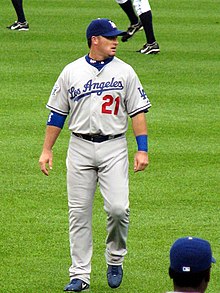
Mark Sweeney, the career pinch hit RBI recordholder, was named to the All-America Team in 1991 by both the American Baseball Coaches Association and Collegiate Baseball.
An All-American team is an honorary sports team composed of the best amateur players of a specific season for each position—who in turn are given the honorific "All-America" and typically referred to as "All-American athletes", or simply "All-Americans". Although the honorees generally do not compete as a unit, the term is used in U.S. team sports to refer to players who are selected by members of the national media. Walter Camp selected the first All-America team in the early days of American football in 1889. In 1950, the American Baseball Coaches Association (ABCA) selected its first All-American baseball team. It has since chosen All-American teams and a player of the year for each division (National Collegiate Athletic Association (NCAA) Division I, Division II, Division III, National Association of Intercollegiate Athletics, junior college and high school). In 1991, Collegiate Baseball began selecting college All-American, Freshman All-American, and High School All-American teams. Baseball America has selected – since 1981 – pre-season and post-season All-American teams and College Player of the Year honorees.
Various organizations selected All-American lists of the best players for the 1991 NCAA Division I college baseball season. The ABCA, the magazine Baseball America, and Collegiate Baseball were the NCAA-sanctioned selectors. This list only includes players selected to the post-season All-American first team for each selector. However, many All-American selections choose second, third, etc. teams from the remaining eligible candidates. (Full article...) -
Image 14

Roy Halladay, the Opening Day starting pitcher from 2003 to 2009
The Toronto Blue Jays are a Major League Baseball (MLB) team based in Toronto, Ontario. They play in the American League East division. The Blue Jays first played their home games at Exhibition Stadium until 1989, when they moved into the SkyDome, which was renamed Rogers Centre in 2005. The first game of the new baseball season for a team is played on Opening Day, and being named the Opening Day starter is an honour, which is often given to the player who is expected to lead the pitching staff that season, though there are various strategic reasons why a team's best pitcher might not start on Opening Day. The Blue Jays have used 25 different Opening Day starting pitchers in their 43 seasons. The 25 starters have a combined Opening Day record of 15 wins, 16 losses and 12 no decisions. No decisions are only awarded to the starting pitcher if the game is won or lost after the starting pitcher has left the game.
The Blue Jays first Opening Day starting pitcher was Bill Singer, who received a no decision against the Chicago White Sox. Roy Halladay holds the Blue Jays' record for most Opening Day starts with seven consecutively from 2003 to 2009, and has an Opening Day record of 3–3. Halladay also has the most starts at home with four. Dave Lemanczyk has the worst winning percentage as the Opening Day starting pitcher with a record of 0–2, both of which were pitched away from Exhibition Stadium. (Full article...) -
Image 15

In baseball, a strikeout occurs when a pitcher throws three strikes to a batter during his time at bat. Under Rules 6.05 and 6.09 of the Official Rules of Major League Baseball, a batter becomes a runner when a third strike is not caught by the catcher with no runner on first base or when there are two outs. The strikeout is recorded, but the batter-runner must be tagged or forced out in order for the defensive team to register the out. Thus, it is possible for a pitcher to record more than three strikeouts in an inning.
As a result of this rule, 93 different pitchers have struck out four batters in a half-inning of a Major League Baseball (MLB) game, the most recent being Tyler Glasnow of the Tampa Bay Rays on July 7, 2023. Five players – Chuck Finley, A. J. Burnett, Zack Greinke, Craig Kimbrel, and Tyler Glasnow – have accomplished the feat more than once in their career (Finley is the only one to do it three times, and all three times were within a one-year span); no player has ever struck out more than four batters in an inning. Ed Crane was the first player to strike out four batters in one inning, doing so in the fifth inning for the New York Giants against the Chicago White Stockings on October 4, 1888. (Full article...)
More did you know
- ... that baseball Hall of Famer Rogers Hornsby had his first plate appearance against King Lear?
- ... that the Philadelphia Phillies were the last of the original 16 Major League Baseball franchises to win the World Series?
- ... that Harry Blackmun's colleagues on the U.S. Supreme Court felt his long history of baseball in the Flood v. Kuhn majority opinion was beneath the Court's dignity?
- ... that the Danville 97s minor league baseball team name of 97s was selected as a tribute to the victims of the Wreck of the Old 97 train accident?
- ... that Frank Graham called Dave Bancroft "the greatest shortstop the Giants ever had and one of the greatest that ever lived"?
Sports portals
Selected picture
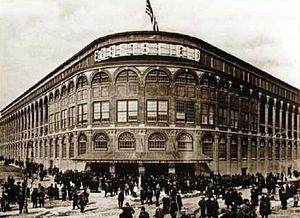
| Credit: Unknown |
Ebbets Field was a Major League Baseball park located in the Flatbush section of Brooklyn, New York. It was the home of the Brooklyn Dodgers of the National League. Two different incarnations of a Brooklyn Dodgers football team also played at the stadium. The park opened on April 9, 1913, and was demolished in 1960, three years after the team relocated to Los Angeles.
Associated Wikimedia
The following Wikimedia Foundation sister projects provide more on this subject:
-
Commons
Free media repository -
Wikibooks
Free textbooks and manuals -
Wikidata
Free knowledge base -
Wikinews
Free-content news -
Wikiquote
Collection of quotations -
Wikisource
Free-content library -
Wikiversity
Free learning tools -
Wiktionary
Dictionary and thesaurus
More portals
- Portals with triaged subpages from June 2018
- All portals with triaged subpages
- Portals with no named maintainer
- Automated article-slideshow portals with 51–100 articles in article list
- Automated article-slideshow portals with 501–1000 articles in article list
- Random portal component with 41–50 available subpages
- Automated article-slideshow portals with 201–500 articles in article list
- Random portal component with 11–15 available subpages
- Random portal component with 21–25 available image subpages

